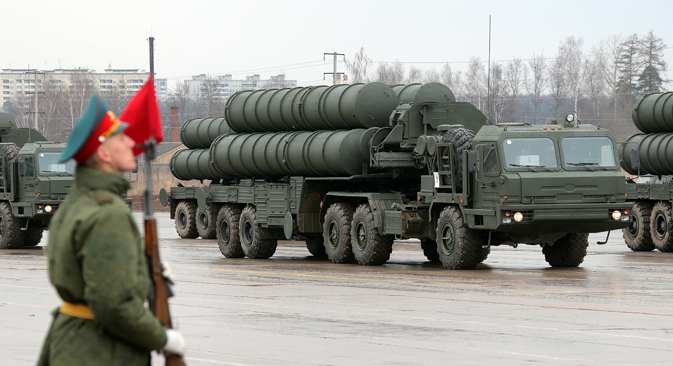
Launchers of the S-400 Triumph surface-to-air missile system take part in the first major rehearsal for the upcoming Victory Day Parade that involves military aircraft, unmounted parade details and a mechanized column in Alabino in the Moscow Region, Apr. 16, 2014. Source: Vitaliy Belousov / RIA Novosti
Air defense systems appeared as soon as airplanes were spotted over the battlefields of World War I. It is still not clear who was the first in Russia to use military planes and how successfully, but by 1915 all the warring countries had airplanes in their arsenals.
The first anti-aircraft system in Russia was created after the beginning of WWI and protected Petrograd [St. Peterburg], the Russian capital at the time. As was no special anti-aircraft technology at the time, 75-mm navy canons were adapted to shoot at the sky and thus defend the city.
The Russian defenders' first success occurred only after a year, when an anti-aircraft unit under the leadership of Captain V. Tarnavsky shot down a plane for the first time in Russian history, a German one. On Dec. 13, 1915 General Alexeyev, head of the Supreme Headquarters, signed a decree on the formation of four separate light batteries "for firing on military airplanes."
In 1932 the Soviet Union began developing a single anti-aircraft system. By the beginning of WWII the anti-aircraft's destroyer aviation had received I-15 destroyers, and later the even faster YAK-3s. These were equipped with the 85-mm, 76-mm and 37-mm anti-aircraft guns. The military then acquired projectors, new, more powerful radio transmitters, reliable wire communication, cars and other technology.
Early on the morning of June 22, 1941 Russia's anti-aircraft units were the first to enter battle. Soviet fighters, which were then part of the air force, engaged the Germans but suffered heavy losses. Then the anti-aircraft systems in the large cities went into action. Throughout the war they, along with the air force destroyers, were able to eliminate more than 7,000 enemy aircraft.
The war became an important lesson for generals who understood the necessity of introducing a centralized anti-aircraft command and supplying it with fighter planes.
The Soviet anti-aircraft system began its rearmament in the 1950s. The appearance of nuclear weapon carriers with intercontinental range (V-50 and V-36 airplanes) after the war rendered air defense strategically important.
In the post-war years the U.S. and its allies, with their planes being unreachable, violated the USSR's borders on many occasions. There were 32 occasions in 1952 alone, and only three invading planes were shot down and another three were damaged. This led to the acceleration of rearmament.
In the beginning of the 1950s the Soviet air force acquired the Mig-15, Mig-17 and Yak-25 fighters. In the middle of that decade the air force received its first supersonic Mig-19 fighter, and then the supersonic SU-11, SU-15 and Yak 28P high-altitude interceptors, guided air missiles and the anti-aircraft S-75 ground missiles. By the beginning of the 1960s the combat potential of Soviet air defense had doubled.
The late 60s-early 70s was a crucial period. In those years anti-aircraft aviation was supplied with the third generation Mig-23 fighter-interceptors, capable of intercepting low-flying targets, as well as with the high-speed Mig-25s. These interceptors received the new long and medium-range R-23 and R-40 guided missiles.
In the 1970s the development of the anti-aircraft system was conditioned by the enemy's small-size strategic winged missiles. The Soviet response was the Mig-31 and SU-27 planes, which were armed with sighting systems capable of detecting the enemy at a great distance and accompanying several air targets simultaneously, as well as with more perfected anti-aircraft systems such as the S-200.
Today parts of the anti-aircraft missile forces are supplied with the Triumph S-400 missile systems and the Panzir-S anti-aircraft gun systems. The S-400 system is capable of hitting targets at an altitude of 185 km.
In the last several years the military has observed a trend toward uniting the commands of the forces active in defending the skies. In December 2011 a new type of force was created by combining the space forces and forces of the operative-strategic command of the aerospace defense – the Aerospace Defense Forces.
In 2015 Russia is planning to unite the Air Force and the Aerospace Defense Force into a new Russian armed force. It is reviewing the post-WWII trend of uniting the forces under one command in order to achieve more efficient control.
The Russian missile defense system is known for its sophisticated capabilities. Even American forces have recently acknowledged this, with a former intelligence officer for the U.S. Air Force, declaring that Russia has one of the best missile defense systems on the planet.
Hypersonic pilotless aircraft are set to become the next phase in
the military technical standoff between Moscow and Washington. In
response to America’s Doctrine of Pre-Emptive Strikes, Russia is
preparing to unveil a space shield with no less of a global reach, that
of her Aerospace Defense Forces.
All rights reserved by Rossiyskaya Gazeta.
Subscribe
to our newsletter!
Get the week's best stories straight to your inbox